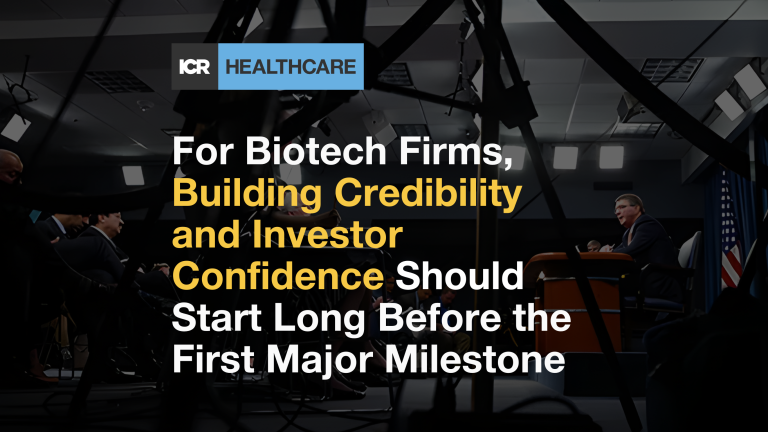The transformative potential of regenerative medicine was in the spotlight at the inaugural Cell & Gene Meeting on the Mediterranean in Barcelona, Spain, held on 23-25 April. The conference, organised by the Alliance for Regenerative Medicine (ARM), was supported by Consilium Strategic Communications, event Media Partner and ARM’s retained communications advisor for Europe.
The conference brought together the cell and gene therapy community from Europe and beyond to discuss ongoing progress and how best to turn the promise of regenerative medicines, or advanced therapeutic medicinal products (ATMP), into a reality that benefits patients and healthcare systems.
Janet Lambert, Chief Executive Officer of ARM, opened the event by summarising the scale of the regenerative medicine industry in Europe and its increasing maturity, with four advanced therapy approvals expected in the relatively near term: bluebird bio’s Zynteglo, Kiadis Pharma’s ATIR01, AxeXis/Novartis’s Zolgensma and Orchard Therapeutics’ OTL-200.
“Of 904 regenerative medicine companies worldwide, 233 are in Europe and Israel and there are more than 324 active ATMP clinical trials, including 50 in Phase III. The financing environment is also strong, according to ARM’s figures, with €488.3M raised in Q1 2019 (up 143% vs Q1 2018).”
Janet Lambert
Chief Executive Officer of ARM
This maturity brings great opportunities for patients but also challenges, many of which were discussed during the conference.
In his keynote address, Guido Rasi, Director General of the European Medicines Agency, stated that the
“expectations for these medicines are enormous”
Guido Rasi
Director General of the European Medicines Agency
and highlighted the tailored regulatory systems in place in Europe and the progress being made towards getting more therapies approved. As this continues, Rasi said, there will need to be new paradigms on evidence generation and reassuring regulators, owing to the small patient numbers in clinical trials. Rasi invoked a “never ending trial” with an initial approval that is later adjusted through the accumulation of real-world evidence.
However, despite confidence in the ability of regulators to overcome obstacles and adapt, Rasi raised what would be a key theme of the conference – the challenge of patient access and reimbursement.
“It is essential that we don’t become a body that approves a drug no one can access.”
Guido Rasi
Director General of the European Medicines Agency
Jeff Walsh, Chief Strategic Officer of bluebird bio, shared his view that the ATMP sector has overcome multiple hurdles in science and manufacturing, but the biggest remaining challenges are those of commercial access.
“How do you create an environment where patients can get access to these therapies in a robust way, and yet still allow for the value proposition to have legs?”
Jeff Walsh
Chief Strategic Officer of bluebird bio
Accepting this was not an “insignificant challenge”, Walsh, however, expressed confidence that due to the significant positive effects of cell and gene therapies on patient lives, “we’ll figure this one out”.
Other key themes to emerge were the complexity and critical importance of manufacturing for ATMPs and also how the industry and wider healthcare system adapts to the change from a focus on therapies that address small patient populations toward larger, more complex indications. John Dawson, Chief Executive Officer of Oxford BioMedica, which is the only FDA approved provider of commercial lentivectors, commented:
“We are increasing our capacity levels, doubling in the short term and probably more in the future, to meet the expected demand and address the challenge of larger indications that need more vectors delivered.”
John Dawson
Chief Executive Officer of Oxford BioMedica
On a panel entitled Recent Developments and Predictions for the Future of Advanced Therapies, Amy DuRoss, Chief Executive Officer and Co-Founder of Vineti, talked about the opportunity for collaboration to build the infrastructure for increasing numbers of therapies, stating that the US market is effectively operating as a ”beta version” which could be developed and improved to move into other markets in the world.
This was an idea backed up by Sven Kili, former Head of Cell & Gene Therapy Development at GSK. He believes that in addition to collaborating to resolve reimbursement and infrastructure issues, the sector should work together to develop core standards. This way, as ATMPs go from treating tens of patients to thousands, tens of thousands or even millions, companies will be able to draw on set, accepted methods and also avoid the risk of having standards imposed from outside.
The importance of collaboration in technical progression and integration was highlighted by Debra Bowes, Chief Business Officer of MaxCyte. Bowes explained how improvements were continually being made to therapeutic processes, product outcomes (the product being patients’ cells) and, crucially, the reduction in time from identifying the patient to extracting their cells and returning them once modified – a key feature of MaxCyte’s CARMA platform. She was optimistic, but concluded that there was much hard work left to do:
“We’re all working and collaborating to improve those processes, but we’ve got a way to go.”
Debra Bowes
Chief Business Officer of MaxCyte
Whilst the challenges faced by developers were well recognised, the overall tone of the conference was one of optimism for the industry and for the impact on regenerative medicine, as summed up by Shane De Bhrun-Smith, healthcare analyst at Cannacord Genuity. Talking about potentially curative treatments in oncology and other diseases, he said: “I think the impact of these therapies on patients and their families is very profound… from all stakeholders and all perspectives, that’s tremendously exciting.”
Consilium, in collaboration with Brandcast Media, interviewed multiple key figures in the ATMP industry and these videos are available on the ARM Twitter account (@alliancerm).



